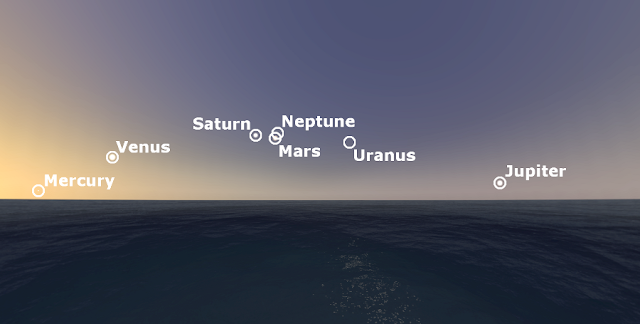Currently, the whole solar system can be seen in the night sky simultaneously, giving astronomers a "spectacular" display to close the year.
Over the next several days, it will be possible to see Uranus and Neptune with binoculars or a telescope, while Mercury, Venus, Mars, Jupiter, and Saturn may all be seen at the same time with the unaided eye.
Gianluca Masi, an astronomer with the Virtual Telescope Project, told Newsweek that on evenings, just after sunset, "we may see all the planets of our solar system at a look." It occasionally occurs, yet it is always a breathtaking sight.
After December 24, the moon will also join the display, which, if the skies are clear, may be viewed from everywhere on Earth.
The planets that can be seen with the unaided eye will line up in the following sequence, starting from the southwest horizon: Venus, Mercury, Saturn, Jupiter, and Mars. Due to its location in a bright area of the sky, Mercury will be the most difficult planet to spot.
Although the planet could be visible with the unaided eye, binoculars might be useful for finding it and Venus.
Binoculars are also necessary to locate Neptune, which is placed between Saturn and Jupiter, and Uranus, which is situated between Mars and Jupiter.
This manner, Masi continued, "we can view the whole planetary family."
This "planetary procession" doesn't happen often, but it's not as uncommon as you would think—on average, such an alignment happens every one to two years.
In June of this year, all of the planets were visible in the sky at once. The five visible planets—Mercury, Venus, Mars, Jupiter, and Saturn—were also lined up in the sky during this display in the same chronological sequence as they circle the sun physically. A similar alignment hadn't happened in 18 years.
With binoculars, Uranus and Neptune were also visible during this occurrence, although they were not aligned in descending order of solar distance.
You only have a few days to get a peek of the most recent planetary procession since Mercury will disappear at the end of the year.
The Virtual Telescope Project will be offering a live broadcast depicting the planets and the moon over the Rome cityscape if you'd like to witness the spectacle from the comfort of your home.
The Bellatrix Astronomical Observatory in Ceccano, Italy, run by Masi, offers the Virtual Telescope Project as a service, which manages and gives access to robotic, remotely controlled telescopes.
The Christmas live stream is scheduled to start on December 28 at 4 UTC, or 11 A.M. Eastern Time.














No comments